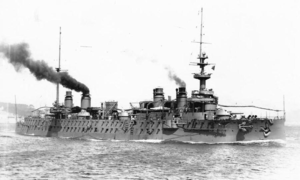 Gloire in 1913
| |
| Class overview | |
|---|---|
| Name | Gloire |
| Operators | |
| Preceded by | Dupleix class |
| Succeeded by | Léon Gambetta class |
| Built | 1899–1904 |
| In commission | 1904–1933 |
| Completed | 5 |
| Lost | 2 |
| Scrapped | 3 |
| General characteristics | |
| Type | Armored cruiser |
| Displacement | 9,996 t (9,838 long tons) |
| Length | 139.78 m (458 ft 7 in) (o/a) |
| Beam | 20.2 m (66 ft 3 in) |
| Draft | 7.55 m (24.8 ft) |
| Installed power |
|
| Propulsion | 3 shafts, 3 triple-expansion steam engines |
| Speed | 21 knots (39 km/h; 24 mph) |
| Range | 6,500 nautical miles (12,000 km; 7,500 mi) at 10 knots (19 km/h; 12 mph) |
| Complement | 615 |
| Armament |
|
| Armor |
|
The Gloire class consisted of five armored cruisers built for the French Navy (Marine Nationale) during the first decade of the 20th century. Fitted with a mixed armament of 194-millimeter (7.6 in) and 164.7-millimeter (6.5 in) guns, the ships were designed for service with the fleet. After their completion in 1903–1904, the five sister ships were initially assigned to the Northern Squadron (Escadre du Nord), often serving as flagships. Sully was transferred to the Far Eastern Squadron (Escadre de l'Extrême-Orient) shortly afterwards and was wrecked when she struck an uncharted rock in February 1905. Marseillaise and Condé were transferred to the Mediterranean Squadron (Escadre de la Méditerranée) in 1905–1906. The surviving sisters were generally divided between the Northern and Mediterranean Squadrons until a reorganization in 1910 caused all but Amiral Aube to be concentrated in the Mediterranean. The following year another reorganization reduced Amiral Aube to reserve and her sisters were transferred to the 2nd Light Squadron (2e Escadre légère), as the Northern Squadron had been renamed. Gloire became a training ship in 1913 and Amiral Aube was reactivated to replace her. Condé was transferred to the French West Indies in early 1914 where she could monitor events during the Mexican Revolution.
When World War I began in August 1914, the three ships in French waters were assigned to defend Allied shipping in the English Channel and enforce the blockade of Germany while Condé was tasked to hunt down German commerce raiders in the Western Atlantic. Once the defenses of the Channel were completed in 1915, the sisters spent most of the rest of the war patrolling the Atlantic or on convoy escort duties based in either France or the West Indies. Amiral Aube was sent to the Eastern Mediterranean in late 1915 where she patrolled off the coast of Ottoman-controlled territory, but returned to France in early 1916. The ship was sent to Murmansk in early 1918 to support Allied forces when they intervened in the Russian Civil War. Returning home in October, she joined her sisters in the Atlantic Division (Division de l'Atlantique), based in the West Indies, in early 1919.
Marseillaise was assigned to the Baltic Division (Division de la Baltique) on after the war's end in November 1918 and remained there until late 1919. Condé supported Allied forces in North Russia in mid-1919 and covered the evacuation of Allied troops later that year. The Gloire-class ships began to be reduced to reserve in 1920; Amiral Aube and Gloire were stricken from the naval register in 1922 and subsequently sold for scrap. Marseillaise served as a training ship in 1925–1929 and was scrapped in 1933. Condé was converted into a barracks ship in 1925 and was seized by the Germans when they invaded France in 1940. They used her as a submarine depot ship before converting her into a target ship; she was sunk by Allied aircraft in 1944.